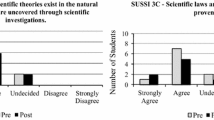Abstract
Using Mendel’s laws as a case in point, the purpose of this paper is to bring historical and philosophical perspectives together to help students understand science as a human endeavor. Three questions as addressed: (1) how did the Mendelian scheme, principles, or facts become labeled as laws, (2) to what extent do Mendel’s laws exhibit characteristics of scientific laws, and (3) what are the implications for biology education. This paper argues that adding historical details about Mendel’s successors and their actions at the time, coupled with explicit consideration of the particular nature of biological laws can provide educators and learners a more comprehensive account for understanding Mendel’s laws, their explanatory and predictive functions, as well as the social context that facilitated their appropriation by the wider scientific community.
Similar content being viewed by others
References
Allchin, D. (2000). Mending mendelism. The American Biology Teacher, 62(9), 633–639.
Allchin, D. (2003). Scientific myth-conceptions. Science Education, 87(3), 329–351.
Allchin, D. (2012). The Minnesota case study collection: New historical inquiry case studies for nature of science. Science & Education, 21(9), 1–19.
Brush, S. (1989). History of science in science education. Interchange, 20(2), 60–70.
BSCS. (2003). BSCS biology: A human approach (2nd ed.). Dubuque: Kendall Hunt.
Dagher, Z., Brickhouse, N., Shipman, H., & Letts, W. (2004). How some college students represent their understanding of scientific theories. International Journal of Science Education, 26, 735–755.
Dagher, Z. R., & Erduran, S. (2014). Laws and explanations in biology and chemistry: Philosophical perspectives and educational implications. In M. Matthews (Ed.), International handbook of research in history and philosophy for science and mathematics education (pp. 1203–1233). Dordrecht: Springer.
Dhar, P., & Giuliani, A. (2010). Laws of biology: Why so few? Systems and Synthetic Biology, 4, 7–13.
dos Santos, V. C., Joaquim, L. M., El-Hani, C. N. 2012. Hybrid deterministic views about genes in biology textbooks: A key problem in genetics teaching. Science & Education, 21(4), 543–578.
Erduran, S., & Dagher, Z. (2014). Reconceptualizing the nature of science for science education: Scientific knowledge, practices and other family categories. Dordrecht: Springer.
Fairbanks, D. (2008). Mendelian controversies: An update. In A. W. Allan Franklin, W. F. Edwards, D. J. Fairbanks, & D. L. Hartl (Eds.), Mendelian controversies: Ending the mendel-fisher controversy (pp. 302–312). Pittsburgh: Pittsburgh University Press.
Fairbanks, D. J., & Rytting, B. (2001). Mendelian controversies: A botanical and historical review. American Journal of Botany, 88(5), 737–752.
Falk, R. (2006). Mendel’s impact. Science in Context, 19, 215–236.
Gibbs, A. & Lawson, A. E. (1992). The nature of science as reflected by the work of biologists and biology textbooks. The American Biology Teacher, 54, 3137–3152.
Heering, P., Klassen, S., Metz D. (Eds.). (2013). Enabling scientific understanding through historical instruments and experiments in formal and non-formal learning environments. In: Flensburg studies on the history and philosophy of science in science education (2nd volume). Flensburg: Flensburg University Press.
Kampourakis, K. (2013). Mendel and the path to genetics: Portraying science as a social process. Science & Education, 22(2), 293–324.
Klassen, S. (2010). The relation of story structure to a model of conceptual change in science learning. Science & Education, 19(3), 305–317.
Kugler, C. (2002). Darwin’s theory, Mendel’s laws: Labels and the teaching of science. The American Biology Teacher, 64(5), 341–351.
Marks, J. (2008). The construction of mendel’s laws. Evolutionary Anthropology, 17, 250–253.
Matthews, M. (1994). Science teaching: The role of history and philosophy of science. New York: Routledge.
Matthews, M. (2014). The contribution of history and philosophy of science, 20th Anniversary Revised and Expanded. New York: Routledge.
Mayr, E. (2004). What makes biology unique? Cambridge: Cambridge University Press.
McComas, W. (1998). The principal elements of the nature of science: Dispelling the myths. In W. McComas (Ed.), The nature of science in science education (pp. 53–70). Dordrecht: Kluwer.
Milne, C. (1998). Philosophically correct science stories? Examining the implications of heroic science stories for school science. Journal of Research in Science Teaching, 35, 175–187.
Mitchell, S. (2009). Unsimple truths. Chicago: University of Chicago Press.
National Research Council. (1996). National science education standards. Washington: National Academies Press.
National Research Council. (2012). A framework for K-12 science education. Washington: National Academies Press.
NGSS Lead States. (2013). Next generation science standards: For states, by states. Appendix H. Washington: National Academies Press.
Norris, S. P., & Philips, L. M. (2003). How literacy in its fundamental sense is central to scientific literacy. Science Education, 87(2), 224–240.
Reece, J. B., Urry, L. A., C, Michael L., Wasserman, S. A., Minorsky, P. V., & Jackson, R. B. (2014). Campbell biology (10th ed.). Boston: Pearson.
Rudge, D. (2003). The role of photographs and films in Kettlewell’s popularizations of the phenomenon of industrial melanism. Science & Education, 12(3), 261–287.
Sapp, J. (1990). The nine lives of Gregor Mendel. In H. K. Le Grand (Ed.), Experimental inquiries (pp. 137–166). Dordrecht: Kluwer Academic Publishers.
SEPUP. (2011). Biology: Science & global issues. Berkeley: Lawrence Hall of Science.
Author information
Authors and Affiliations
Corresponding author
Additional information
An earlier version of this paper was published in Heering et al. (2013). Enabling scientific understanding through historical instruments and experiments in formal and non-formal learning environments (pp. 303–312). Flensburg: Flensburg University Press.
Rights and permissions
About this article
Cite this article
Dagher, Z.R. The Relevance of History of Biology to Teaching and Learning in the Life Sciences: The Case of Mendel’s Laws. Interchange 45, 205–216 (2014). https://doi.org/10.1007/s10780-015-9241-y
Received:
Accepted:
Published:
Issue Date:
DOI: https://doi.org/10.1007/s10780-015-9241-y




